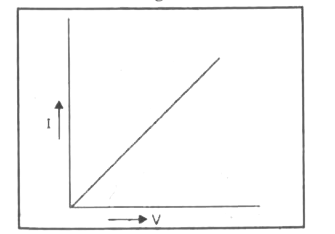Explain the Ohm's law.
Video Solution
Text Solution
Ohm.s law states that current flowing through c conductor is proportional to the potential difference across its two ends provided the physical conditions of the conductor remain unchanged.

if V is the potential difference between two ends of a conductor and I is the current flowing through it, then from Ohm.s law we have
V∝IorV=RI
where R is the constant of proportionality and is called the resistance of the conductor. the graph between V and I is as shown in the figure.
|
Similar Questions
Knowledge Check
Ohm's law is .
AV=RlBl=V×RCR=V2×lDV = l RIn case of liquids, the Ohm's law is
Afully obeyedBpartially obeyedCnever obeyedDsometimes obeyedWhich of the following obey's Ohm's law?
ATransistorBNichromeCDiodeDLiquid electrolyte
State Ohm's law. How can it be verified experimentally ? Explain with the help of a circuit diagram. Express the result graphically.
View SolutionIs Ohm's law universally applicable for all conducting elements? If not, give examples of elements which do not obey Ohm's law.
View SolutionAccording to Ohm's law V = IR, then
View SolutionAccording to Ohm's law V = IR, then
View SolutionWhich of the following represents the ohm's law ?
View Solution

